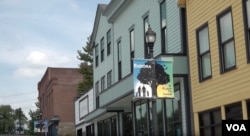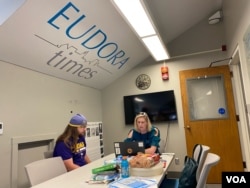For about a decade, Eudora, Kansas, counted itself among the many small towns across the U.S. that no longer had their own newspapers.
The recession marked the end of its local paper in 2009, turning Eudora into what is known as a “news desert” — a region that has no dedicated media coverage.
Then Teri Finneman, a journalist-turned-media professor at the University of Kansas, stepped in. Her solution: The Eudora Times, a student-led outlet that has brought news back to this town of 6,500 people.
“A lot of the coverage that we do wouldn’t be considered newsworthy with a capital N,” Finneman told VOA. But that doesn’t matter to The Eudora Times, because that’s not the point of the outlet, she said.
“We very much want to be a service organization and a partner with our community,” Finneman said. The paper’s focus: covering what matters to residents.
Tough times
The Times is a rare good-news story at a difficult time for the industry. By bringing back local news, the paper helped to reinvigorate the community while pioneering a road map that may help address news deserts elsewhere.
“Before we had The Eudora Times, I didn’t know really anything that was going on in the community, other than things a customer would come in and tell me,” said Kathy Weld, owner of Zeb’s Coffeehouse in Eudora. “Before I opened the coffee shop, I didn’t know anything.”
Finneman, who is from a small town in western North Dakota, wanted to fix that.
After some newsy social media posts, the first article was about the 2018 opening of Weld’s coffee shop — named after her dog, Zeb.
Once the article was written, Finneman realized she needed a website to put it on.
“I would get an F in business school for this business plan,” she told VOA as she recalled the paper’s early days from the coffee shop that was first featured. She used online software to create a website within five minutes. "I’m like, Eudora Times - that sounds good. And then we just put it online.”
Lucie Krisman, one of the paper’s founding reporters, said that from that small start, the idea “sort of ramped up.”
“We realized what kind of potential there was to create an honest-to-God newspaper here,” she said. “It grew from literally nothing.”
Thousands of closures
The outlet’s slow beginnings belie its significance not just for Eudora but for local media across the country.
Around a fourth of local and regional newspapers — or 2,500 — have closed since 2005 and one-third are expected to shutter by 2025, according to a report by the Northwestern Medill Local News Initiative.
The hard work is paying off. A member of the Kansas Press Association, The Eudora Times has won several awards, including for its reporting on government and education.
But there are far more communities that will remain or become news deserts, and that’s something that worries Finneman.
“It’s not just the current crisis that needs to be addressed, but it’s the pending crisis,” she said, particularly in the Midwest. “It’s going to be disastrous.”
With the closure of local media outlets across the U.S., more than 14 million Americans are getting their news from student reporters, according to the Center for Community News at the University of Vermont.
Like the Times, those outlets cover everything from local government and politics to school board meetings and high school sports.
“That’s not Watergate-type of coverage,” Finneman said. But it is the kind of coverage that breathes life into towns that are often ignored by the media and are at risk of being left stagnant as a result.
“People want to feel that community connection,” Finneman said.
A difference noticed
Her approach appears to be working, with several Eudora residents telling VOA they have noticed a clear difference since the Times came to town. Eudora is a case study in what happens when a town loses its newspaper — and what happens when the news comes back.
“There’s so much divisiveness in our country. Local news has a way of bringing us together,” Weld, the coffee shop owner, said.
People had relied on getting information “through the grapevine,” said Laura Smith, who helps in-need residents access resources as the town’s community resource navigator.
“With The Eudora Times, they’re everywhere, and they do such a phenomenal job of covering things, that everyone just feels connected,” she said.
For Krisman, now a reporter at the Shawnee Mission Post in Kansas, the paper helps people “be proud of their community.”
“It creates a sense of connectivity that you just can’t really get without having your own news outlet,” Krisman said.
Studies show that the decline of local news often contributes to a rise in polarization and government corruption, the spread of disinformation and misinformation, and a decline in civic engagement.
The Eudora Times had to win the town’s trust when it started.
“Because they did not have local news for so long, because we were still in the era when people were frequently being told that the press was an enemy of the people, there was a lot of concern from people that we were going to be a partisan news outlet,” Finneman said.
Funded by donations, some of which help cover reporters’ expenses, the Times hosted community meetings to help address those concerns. And most interviews are conducted in person to help build trust.
Cami Koons, a former features reporter at the paper, said she thinks people are more likely to trust national media when they have positive experiences with journalists at the local level.
“I really think that just having a positive interaction with a reporter, with some news media, makes such a big difference in people’s opinion of news, and hopefully leads them to trust it a little bit more,” Koons, now a reporter at Kansas City PBS, said. “If you don’t have a paper in town, how are you going to do that?”
Finneman wishes she could fix all the news deserts in the country. For now, she’s turning her sights on the nearby town of De Soto, where Panasonic’s $4 billion electric vehicle battery factory will be located.
De Soto will need media coverage more than ever once the factory opens, and The Eudora Times is preparing to step in, Finneman said. “They also don’t have a newspaper.”










